"I want to tell you that your fact sheet on the [Missile Technology Control Regime] is very well done and useful for me when I have to speak on MTCR issues."
Winning the Game of Chicken With Memes: Ukrainian Reactions to Russian Threats
June 2023
By Valeriia Hesse
Russia made numerous nuclear threats during the first 15 months of its war against Ukraine. Last September, as Russia annexed four Ukrainian regions, claimed them to be under its nuclear shield, and escalated its rhetoric, analysts all over the world assessed the probability of Russia using tactical nuclear weapons as becoming increasingly likely. Understandably, Ukrainians have been alarmed by such an apocalyptic possibility, but they have found a unique way to cope with it through humor and to continue supporting their national leaders in the brutal fight to expel Russian forces from Ukrainian territory.
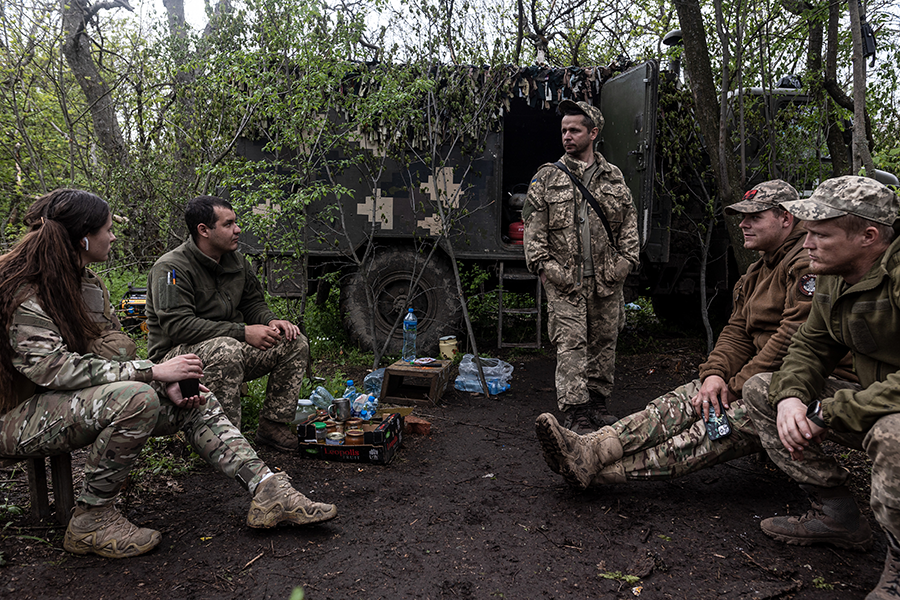 The reactions of Ukrainians show that Russian nuclear threats did not work as expected. Russia’s genocidal rhetoric and Ukraine’s traumatic history have shaped these public reactions. Ukrainians are treating this war as a national survival issue. Although they reasonably suppose that it is possible for the state and the culture as a whole to survive a limited nuclear attack or other catastrophe, such as a nuclear power plant disaster, they do not believe that it is possible to survive full Russian occupation.
The reactions of Ukrainians show that Russian nuclear threats did not work as expected. Russia’s genocidal rhetoric and Ukraine’s traumatic history have shaped these public reactions. Ukrainians are treating this war as a national survival issue. Although they reasonably suppose that it is possible for the state and the culture as a whole to survive a limited nuclear attack or other catastrophe, such as a nuclear power plant disaster, they do not believe that it is possible to survive full Russian occupation.
Nuclear deterrence has worked in accordance with nuclear deterrence theory because Russian nuclear weapons threats and capabilities have played a large role in preventing NATO’s direct involvement in the war and in limiting the kinds of weapons systems that Ukraine’s Western allies are willing to provide. At the same time, Russia’s nuclear brinkmanship has failed so far to intimidate the Ukrainian public and to force its leaders to give in, thus imbuing the future understanding of nuclear deterrence with a curious spin. One way in which Ukrainian perseverance has manifested itself, through humor, has had an unexpected influence on nuclear coercion dynamics.
The Intent of Russian Intimidation
The world understandably has been alarmed by Russia’s nuclear threats because its national military doctrine stipulates that nuclear weapons can be used in conventional conflicts “when the very existence of the state is threatened.”1 From the beginning, it has been clear that if Russia loses this war, the survival of its regime, at a minimum, is under threat. Another Russian document, the Foundations of State Policy of Nuclear Deterrence, names territorial integrity as the main priority protected by Russia’s nuclear deterrent.2 The formulation sounds ambiguous and is difficult to interpret, especially in the light of Russia claiming to be “one” with Ukraine and occupying Ukrainian lands. This uncertainty has left the global community wondering whether the world will see the first battlefield use of nuclear weapons in the 21st century, thus ending the decades-long nuclear taboo.
Russia’s nuclear coercion tactics have underscored the seriousness of the state’s determination to intimidate Ukrainians and suppress any resistance and more so to block external help to Ukraine. “Coerce” can have two meanings: to force and to restrain. Coercion can be defined as latent violence intended at manipulating the target’s perception of costs to prevent them from acting (deterrence, status quo preservation) or to compel them to act (compellence, change of status quo).3 The key is to convince the adversary that losses from actions in the first case and from the lack of desired actions in the second case will significantly exceed the benefits. Accordingly, one important element of these coercion tactics is the opponent’s threat perception.
Intimidation and fear as tactics to obtain a desired result are taking many forms in this war, from Russia’s grave atrocities against civilians to mass missile and drone attacks and devastating strikes on energy infrastructure. All are aimed at forcing civilians to pressure Ukrainian authorities to surrender and the Ukrainian people have seemed to understand this.4 Two of these forms have a nuclear component that instrumentalize radiophobia: nuclear weapons threats and radiological emergency risks.
When Russia invaded Ukraine on February 24, 2022, Russian President Vladimir Putin issued what was interpreted as his first nuclear threat. In a speech, he promised that if other states “obstruct” Russian operations, “Russia will respond immediately, and the consequences will be such as you have never seen in your entire history. No matter how the events unfold, we are ready.” Three days later, the nuclear component of the invasion became more prominent when Putin ordered that Russian deterrence forces be put on high combat alert as an element of nuclear signaling.5 That was the first time since the 1960s that a world leader had issued such a threat publicly.
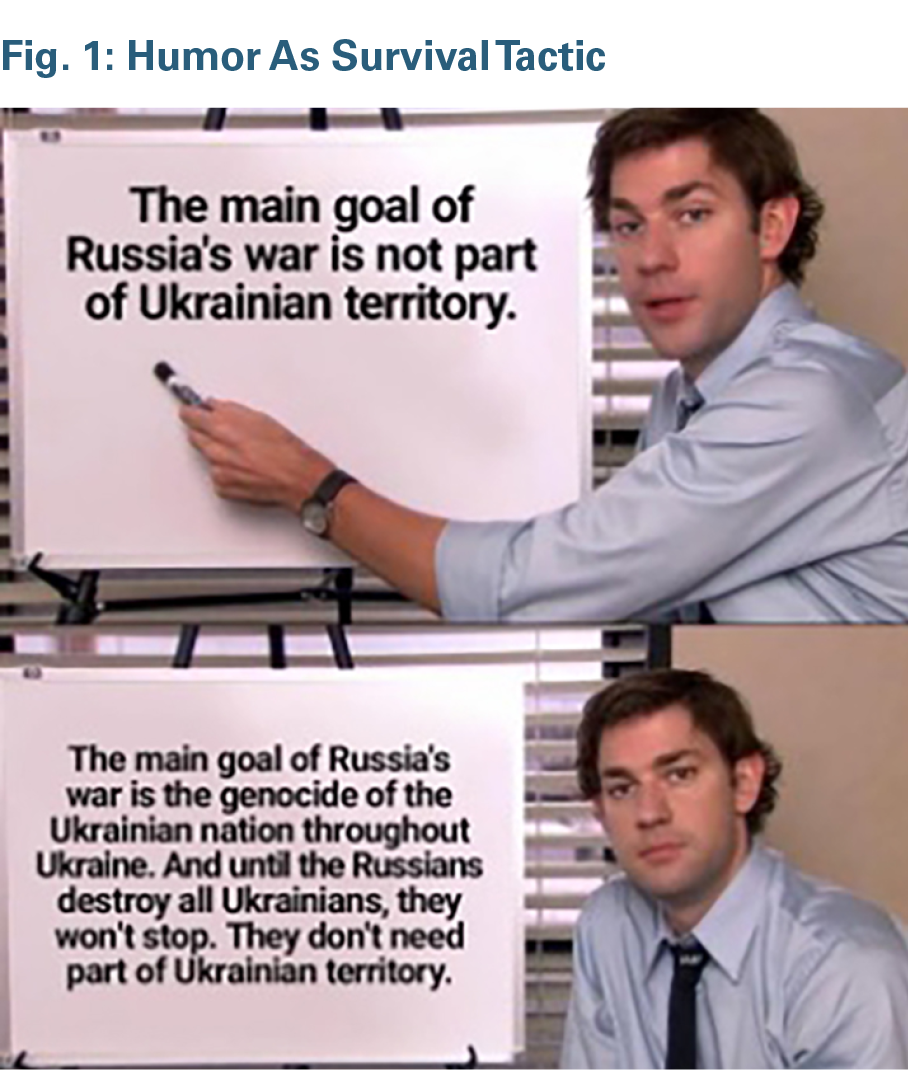 Despite the fact that attacks on nuclear power plants do not fall under the category of nuclear weapons threats, the “nuclear” component of the threats engenders similar types of fears. Radiophobia is an extreme fear of ionizing radiation, which has been studied since the atomic bombings of Hiroshima and Nagasaki in 1945 and has continued to be observed following the latest disaster at Fukushima in 2011.6 Russia’s attacks on and seizures of nuclear power facilities, especially the prolonged occupation of the Zaporizhzhia complex, signify the weaponization of critical infrastructure in Ukraine, the sociopsychological effects of which are exploited for compellence purposes. Such behavior by Russian forces clearly sent a signal enhancing nuclear resolve and showed that Russia has no fear of radioactive contamination. Russian forces and leadership just needed to appear irrational enough to be willing to risk a nuclear catastrophe for the sake of achieving military goals. This tactic resembles the so-called game of chicken that is used to explain nuclear deterrence, in which the leader who seems more irrational and willing to risk nuclear obliteration to protect their core interest wins.
Despite the fact that attacks on nuclear power plants do not fall under the category of nuclear weapons threats, the “nuclear” component of the threats engenders similar types of fears. Radiophobia is an extreme fear of ionizing radiation, which has been studied since the atomic bombings of Hiroshima and Nagasaki in 1945 and has continued to be observed following the latest disaster at Fukushima in 2011.6 Russia’s attacks on and seizures of nuclear power facilities, especially the prolonged occupation of the Zaporizhzhia complex, signify the weaponization of critical infrastructure in Ukraine, the sociopsychological effects of which are exploited for compellence purposes. Such behavior by Russian forces clearly sent a signal enhancing nuclear resolve and showed that Russia has no fear of radioactive contamination. Russian forces and leadership just needed to appear irrational enough to be willing to risk a nuclear catastrophe for the sake of achieving military goals. This tactic resembles the so-called game of chicken that is used to explain nuclear deterrence, in which the leader who seems more irrational and willing to risk nuclear obliteration to protect their core interest wins.
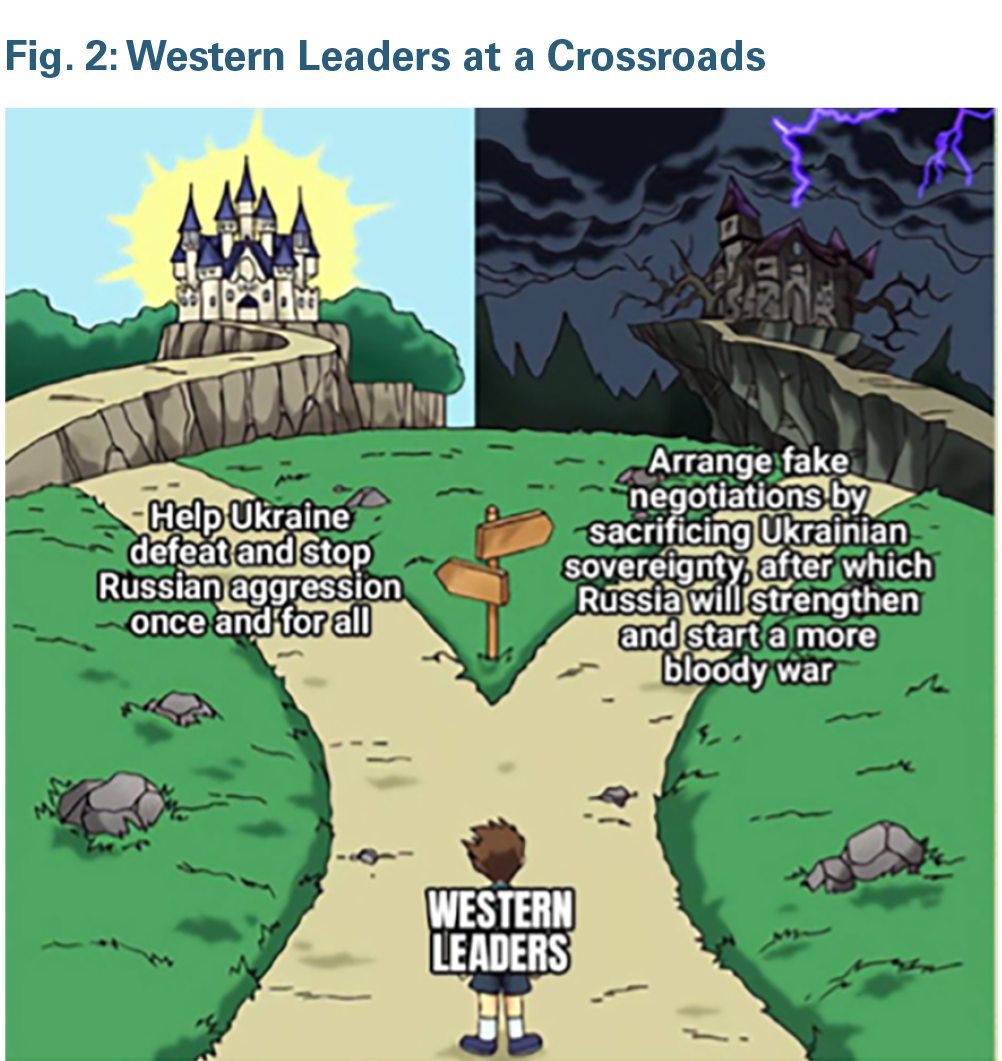 Winning With Memes
Winning With Memes
Russia’s irrationality seemed credible to most external players and helped to successfully deter NATO from intervening in the war directly and from supplying certain types of weapons to Ukraine. Such compellence did not work as expected against Ukrainians. The leadership in Kyiv took the Russian threats seriously but refused to cave. Throughout, the general population has been supportive of the official position in Kyiv because the absolute majority believed that the loss from a Ukrainian surrender would outweigh the loss from experiencing a nuclear strike. For Ukrainians, this is a fight against annihilation. Having heard Russia’s genocidal rhetoric,7 seen what had happened in Bucha and in other previously Russian-occupied territories,8 and remembered the nation’s centuries-long historic trauma,9 Ukrainians decided to ignore the nuclear threats as the only hope to survive as they continued the fight. The nation lived through the biggest nuclear accident in history in 1986 and also saw that there is life after death in the example of modern-day Hiroshima and Nagasaki.
In desperate situations, humor can be a workable survival tactic. Throughout this devastating war, Ukrainians have shown an incredible ability to view their situation through the prism of humor, some of which came directly from the frontline via social media.10 A genre that became particularly popular is wartime memes reflecting major themes that were in line with Ukrainian leadership positions and the views of most Ukrainians.
One theme was the inevitability of perseverance and refusal to surrender (fig. 1).
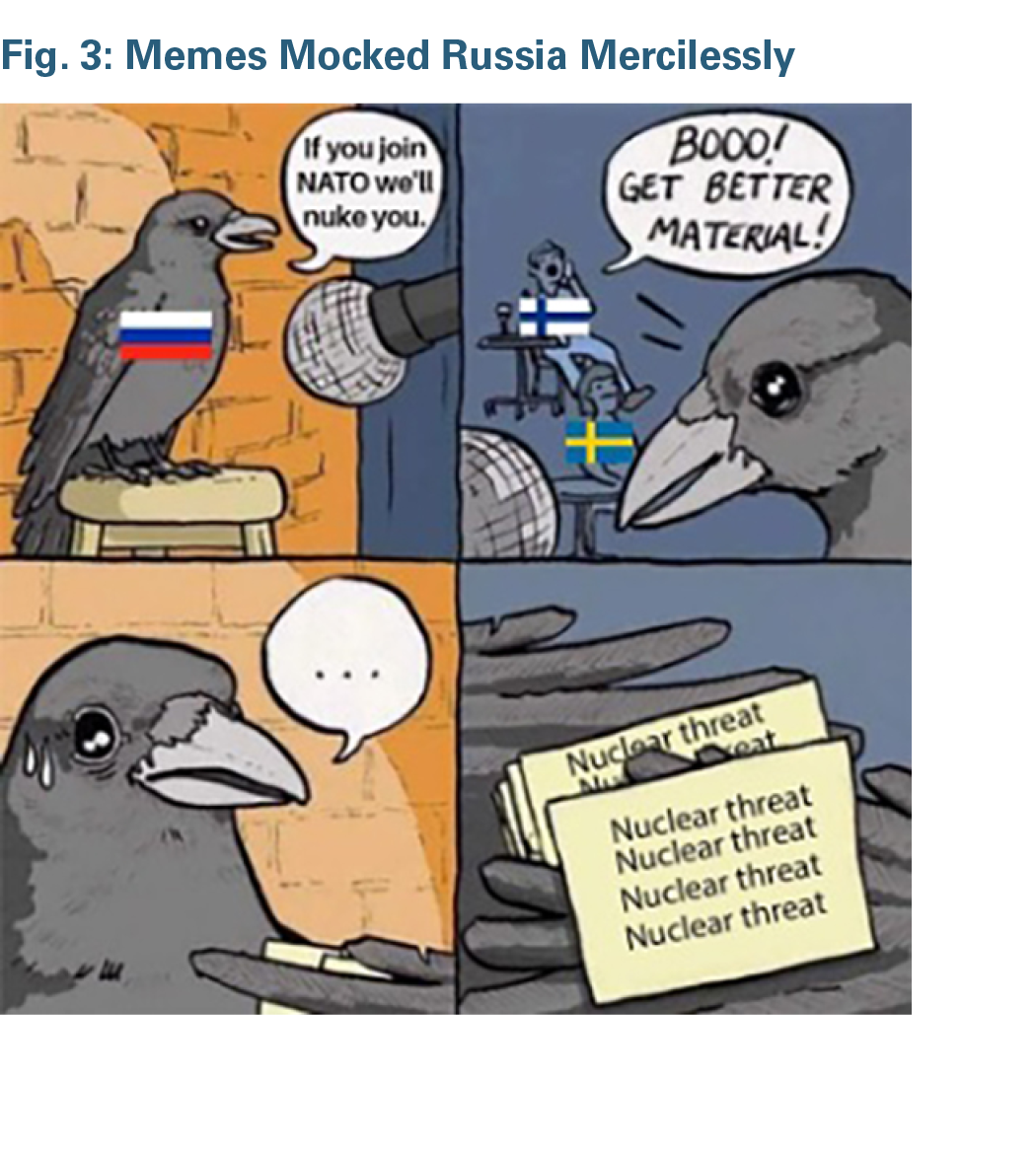 Another theme drew on the fallacy of the idea of a diplomatic solution (fig. 2).
Another theme drew on the fallacy of the idea of a diplomatic solution (fig. 2).
There were also memes mocking Russian nuclear threats (figs. 3 and 4).
As the situation on the ground developed, the first Ukrainian counteroffensive, which started on August 29, achieved significant progress and pushed Putin to more radical actions and rhetoric. Russia eventually realized that it would not conquer the whole of Ukraine and that its calls for Ukrainians to surrender under mass missile attacks were not working. Putin’s goal shifted to preserving Russian territorial gains, especially the land corridor to Crimea. After his decision to hold a referendum on September 21, illegally integrating four Russian-occupied Ukrainian regions into Russia, Putin promised to defend Russia’s territorial integrity using all weapons available, including nuclear systems, and said, “This is not a bluff.”11
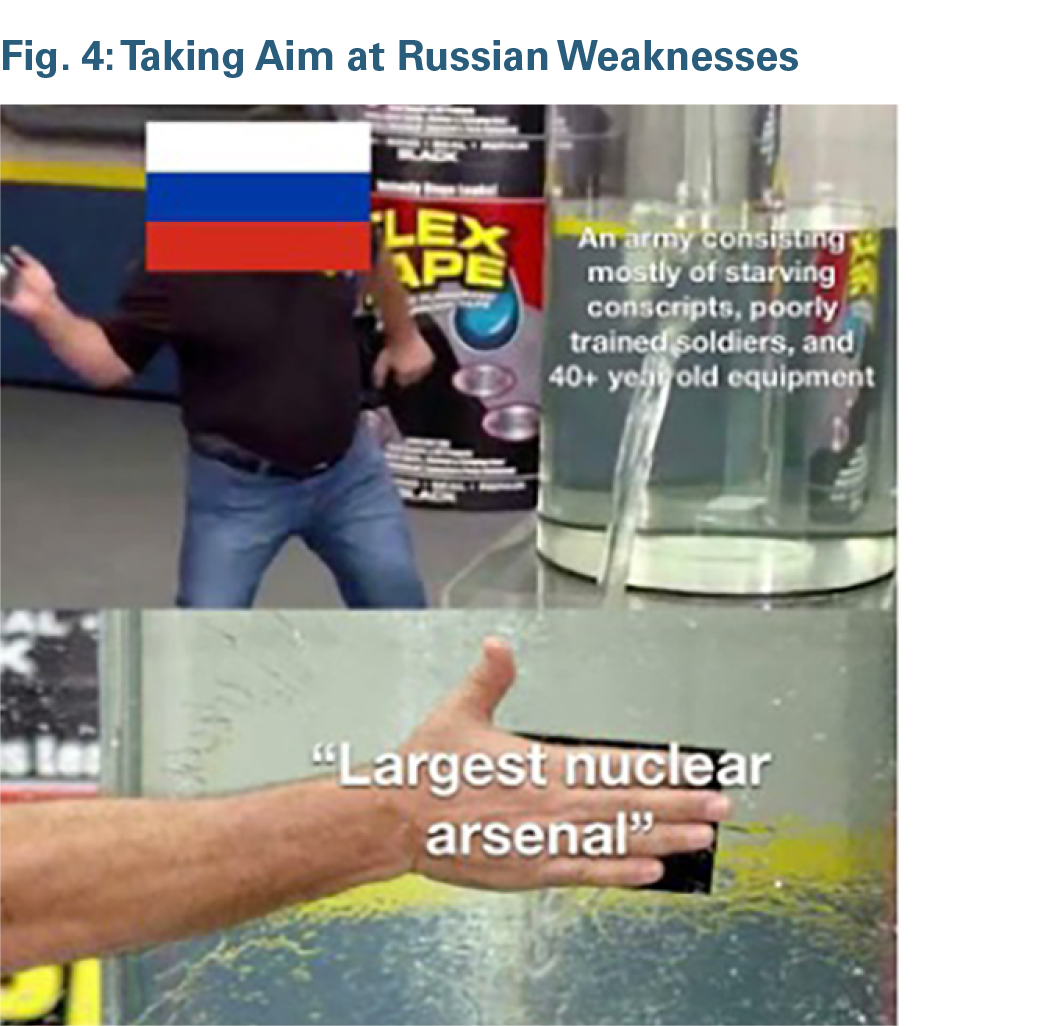 At that point, even the expert community was alarmed. Analysts all over the world started assessing the probability of tactical nuclear weapons use as more significant. Ukrainian media headlines frequently asked, “Will Putin Use Nuclear Weapons?” At the same time, many news articles focused on why there is no sense for Russia to employ nuclear weapons and how it would bring no tactical military advantage.12 In some sense, these articles shaped the general public’s response by outlining credible reasons why Russia would not use nuclear weapons. If there were no military advantage, then the goal of the threats was to intimidate the population and pressure the government to stop fighting. The Ukrainian population seemed to share the realization that if there were a diplomatic compromise and some parts of the state still remained occupied, Russia in time would regain the strength to reignite the war, so Ukrainians kept fighting.
At that point, even the expert community was alarmed. Analysts all over the world started assessing the probability of tactical nuclear weapons use as more significant. Ukrainian media headlines frequently asked, “Will Putin Use Nuclear Weapons?” At the same time, many news articles focused on why there is no sense for Russia to employ nuclear weapons and how it would bring no tactical military advantage.12 In some sense, these articles shaped the general public’s response by outlining credible reasons why Russia would not use nuclear weapons. If there were no military advantage, then the goal of the threats was to intimidate the population and pressure the government to stop fighting. The Ukrainian population seemed to share the realization that if there were a diplomatic compromise and some parts of the state still remained occupied, Russia in time would regain the strength to reignite the war, so Ukrainians kept fighting.
In this period of high tension, Ukrainians once again resorted to humor, creating a shocking and effective paradoxical ridicule of nuclear war that went viral, eventually reaching Russian TV and Russian political ears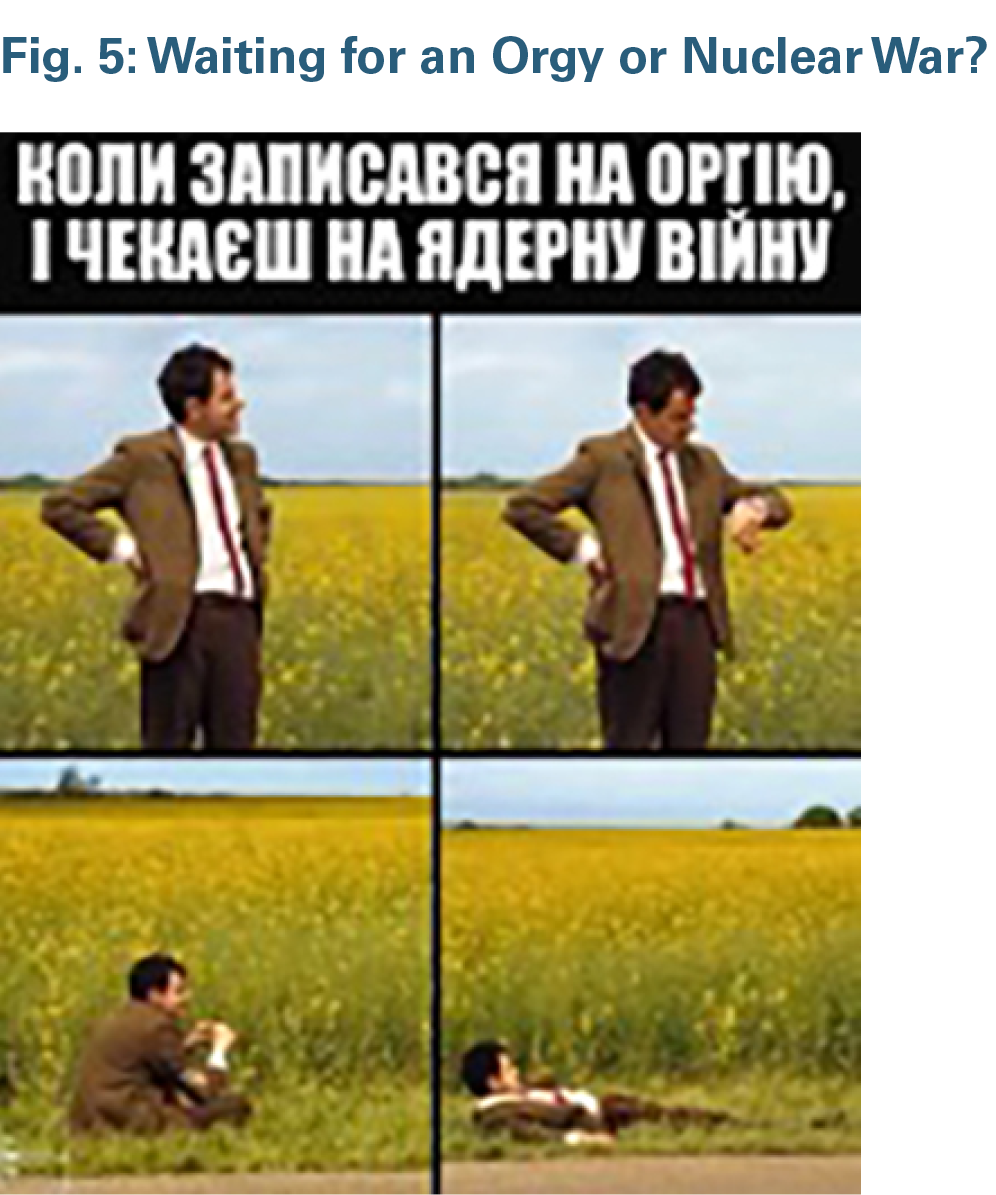 .13 On September 24, as Moscow continued what you might call a this-is-not-a-bluff approach, some members of the Kyiv Telegram messenger community proposed holding an orgy at Shchekavytsia, an area in Kyiv, in case of a nuclear strike.14 In addition to ordinary citizens, famous people, network providers, and grocery store chains produced numerous jokes and memes about it (figs. 5 and 6).15
.13 On September 24, as Moscow continued what you might call a this-is-not-a-bluff approach, some members of the Kyiv Telegram messenger community proposed holding an orgy at Shchekavytsia, an area in Kyiv, in case of a nuclear strike.14 In addition to ordinary citizens, famous people, network providers, and grocery store chains produced numerous jokes and memes about it (figs. 5 and 6).15
Bolstered by strong international diplomatic pressure on Moscow16 and strong Ukrainian public support for Kyiv’s determination to continue fighting, this reaction reflecting the public’s threat perception has shaped the wartime narrative. Failing to achieve its intended purpose, Russia has dialed down the nuclear rhetoric. In a major speech on October 27, Putin was much less provocative when he said, “After all, we have never said anything proactively about Russia potentially using nuclear weapons. All we did was hint in response to statements made by Western leaders.”17 Moreover, on November 2, the Russian Ministry of Foreign Affairs reaffirmed the 2022 joint statement by the leaders of the five nuclear-weapon states on preventing nuclear war.
Ever since then, Moscow’s nuclear rhetoric has become significantly less prominent in the war context. For example, Russia’s previously stated redline was the supply of long-range weapons systems or more powerful Western weapons systems to Ukraine.18 Yet, despite agonizing over the decision, many nations have delivered tanks and other heavy weapons and systems to Ukraine; and luckily, no nuclear strike fol lowed. Even more surprising, Dmitry Medvedev, deputy chairman of the Russian Security Council, who often wields a nuclear-threat bullhorn, did not even mention using the entirety of Russia’s nuclear potential in response to increasingly frequent Ukrainian strikes on Crimea. Instead, he limited himself to promising conventional punishment on the battlefield and “retribution against key figures of the Nazi regime,” a disparaging reference to the Ukrainian government.19
lowed. Even more surprising, Dmitry Medvedev, deputy chairman of the Russian Security Council, who often wields a nuclear-threat bullhorn, did not even mention using the entirety of Russia’s nuclear potential in response to increasingly frequent Ukrainian strikes on Crimea. Instead, he limited himself to promising conventional punishment on the battlefield and “retribution against key figures of the Nazi regime,” a disparaging reference to the Ukrainian government.19
Ukraine is an unprecedented example of how little is known about the power of humor and social media to influence international politics and how individuals can start a butterfly effect of public engagement contributing to dramatic turns in global politics. The game of chicken is what unites deterrence and compellence, nuclear weapons threats, and hybrid threats exploiting radiophobia, and Russia seems to be losing it to memes. Of course, it is not the humor per se that won the game in this chapter of the war but rather the population’s threat perception and the consequent conventional military resolve. Ridicule of Russia united Ukrainians to defend their country and, for now at least, has killed Russian hopes of pressuring Ukraine’s leadership to change its behavior and cave.
ENDNOTES
1. Rossiyskaya Gazeta, “Military Doctrine of the Russian Federation,” December 30, 2014, https://rg.ru/documents/2014/12/30/doktrina-dok.html (in Russian).
2. President of Russia, “Decree of the President of the Russian Federation of June 2, 2020,
No. 355,” n.d., http://www.kremlin.ru/acts/bank/45562 (in Russian).
3. Thomas Shelling, Arms and Influence (London: Yale University Press, 2020), pp. 2-4; Polina Sinovets, Double Faced Yanus or Nuclear Deterrence Theory in the XXI Century (Odesa: Fenix, 2008), pp. 8-9.
4. Victoria Namestnik, “How Russian Propaganda Uses Intimidation Tactics,” Detector Media, February 27, 2023, https://disinfo.detector.media/post/yak-rosiiska-propahanda-vykorystovuie-taktyku-zaliakuvannia; Olha Kotiv, “‘There Is No Chance of Survival’: How Ukraine Met Spring, and Putin’s Winter Terror Failed,” 24 Channel, March 1, 2023, https://24tv.ua/zalyakuvannya-ukrayini-zimoyu-plan-putina-zamoroziti-ukrayintsiv_n2265364.
5. Telegraph, “Putin Declares Military Offensive in Ukraine as Invasion Starts,” YouTube, February 24, 2022, https://youtu.be/_5YeX8eCLgA; Andrew Roth et al., “Putin Signals Escalation As He Puts Russia’s Nuclear Force on High Alert,” Guardian, February 28, 2023, https://www.theguardian.com
/world/2022/feb/27/vladimir-putin-puts-russia-nuclear-deterrence-forces-on-high-alert-ukraine.
6. John C.H. Lindberg and Denali Archer, “Radiophobia: Useful Concept, or Ostracising Term?” Progress in Nuclear Energy, Vol. 149 (July 2022), 104280.
7. Olesya Kotubeii, “Ethnic Cleansing: The Article ‘What Russia Should Do With Ukraine’ Was Published on the Russian State Website,” Suspilne, April 4, 2022, https://suspilne.media/225052-etnicni-cistki-na-derzavnomu-rosijskomu-sajti-vijsla-statta-so-rosia-mae-zrobiti-z-ukrainou/.
8. Richard Connor, “Russia’s Ukraine Violations ‘Shockingly Routine,’” Deutsche Welle, March 31, 2023, https://www.dw.com/en/russias-ukraine-violations-shockingly-routine/a-65196353.
9. Roberto Cancio, Anastasiia Kuptsevych-Timmer, and Marisa Omori, “Perpetual War With the Brother Nation: An Analysis of Ukrainian Veterans, Cultural Identity and Historical Trauma,” Journal of War & Culture Studies, Vol 13, No. 3 (2020): 219-236; Yaroslava Muzychenko, “The Rake of Russian Atrocities: How Putin’s Russia Continues Three Hundred Years of Terror Against Ukraine,” Radio Liberty, April 7, 2023, https://www.radiosvoboda.org/a/rosiya-zvirstva-viyna-ukrayina/31789267.html#comments.
10. Neil Bowdler, “How Ukrainians Are Using Humor to Boost Wartime Spirits,” Radio Free Europe/Radio Liberty, December 30, 2022, https://www.rferl.org/a/ukrainians-humor-war/32199082.html; Sofiya Maksymiv, “How Humor Helps Ukrainians Withstand War Atrocities,” Ukraine World, July 21, 2022, https://ukraineworld.org/articles/analysis/how-humor-helps-ukrainians.
11. President of Russia, “Address by the President of the Russian Federation,” September 21, 2022, http://en.kremlin.ru/events/president/news/69390.
12. See Olga Mosyondz, “Will the Russian Federation Use Nuclear Weapons Against Ukraine?” ArmyInform, October 7, 2022, https://armyinform.com.ua/2022/10/01/chy-zastosuye-rf-proty-ukrayiny-yadernu-zbroyu/; Tetiana Kovalenko, “Putin Threatens Nuclear Weapons. Will He Use Them,” Korrespondent.net, September 21, 2022, https://ua.korrespondent.net/world/russia/4518463-putin-pohrozhuie-yadernoui-zbroieui-chy-zastosuie-vin-yii; “Putin's Blackmail. Will Russia Use Nuclear Weapons in Ukraine,” Focus, September 24, 2022, https://focus.ua/uk/voennye-novosti/530544-shantazh-putina-chi-zastosuye-rosiya-yadernu-zbroyu-v-ukrajini.
13. Ivan Havrylyak, “Orgy on Shchekavytsia. Rushists Rage About How Ukrainians Reacted to Nuclear Threats (Video),” Glavcom, October 6, 2022, https://glavcom.ua/video/orhija-na-shchekavitsi-rashisti-ljutujut-jak-ukrajintsi-vidreahuvali-na-jaderni-pohrozi-video-880250.htm.
14. Daryna Hrysiuk, “‘The World Was Catching Me, but I’m on Shchekavytsia.’ The Network Discusses the ‘Planned’ Orgy in Case of a Nuclear Attack in Kyiv,” NV, September 27, 2022, https://nv.ua/ukr/lifestyle/shchekavicya-ta-orgiya-pid-chas-yadernogo-udaru-shcho-obgovoryuyut-u-merezhi-kiyani-memi-2022-50272891.html.
15. Mariia Suprun, “‘Orgy on Shchekavytsia’: The Network Was Flooded With Memes About Gatherings of Ukrainians on the Mountain in the Event of a Nuclear Explosion,” Big Kyiv, September 28, 2022, https://bigkyiv.com.ua/orgiya-na-shhekavyczi-merezhu-zapolonyly-memy-pro-zbory-ukrayincziv-na-gori-v-razi-yadernogo-vybuhu/.
16. Paul Sonne and John Hudson, “U.S. Has Sent Private Warnings to Russia Against Using a Nuclear Weapon,” The Washington Post, September 22, 2022; Nectar Gan, “As Russia Raises Nuclear Specter in Ukraine, China Looks the Other Way,” CNN, September 23, 2022, https://edition.cnn.com/2022/09/22/china/russia-mobilization-china-intl-hnk-mic/index.html.
17. President of Russia, “Valdai International Discussion Club meeting,” October 27, 2022, http://en.kremlin.ru/events/president/news/69695.
18. Valery Sharifulin, “The Russian Foreign Ministry Called the Supply of Long-Range Weapons to Kyiv the Red Line for Russia,” Tass, October 9, 2022, https://tass.ru/politika/15998669.
19. Dmitry Medvedev, “The Kyiv Dog Continues to Bark,” Telegram, April 29, 2023, https://t.me/medvedev_telegram/317 (in Russian).
Valeriia Hesse is a researcher at the Odesa Center for Nonproliferation in Ukraine with expertise in nuclear issues, including nonproliferation, security, risk reduction, deterrence, and disarmament. Her research was supported by the International Campaign to Abolish Nuclear Weapons in cooperation with Heinrich-Böll-Stiftung e.V.
